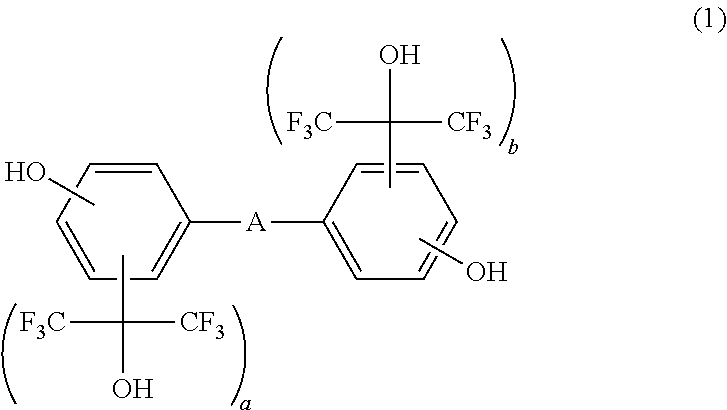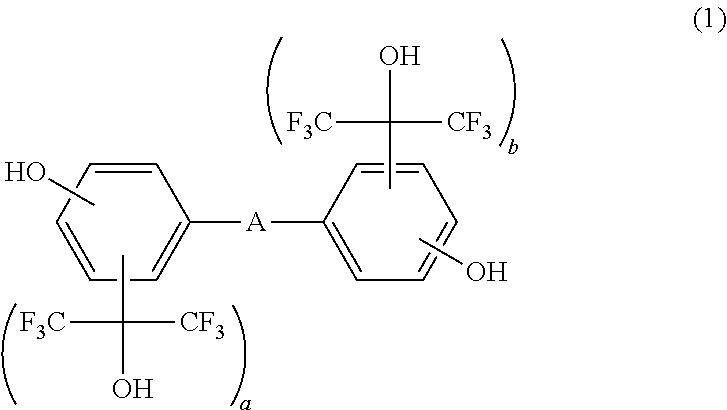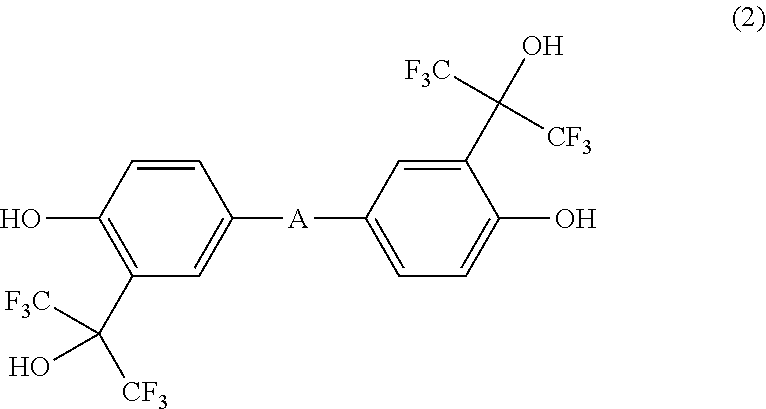Fluorine-containing polymerizable monomer and polymer compound using same
a technology applied in the field of fluorine-containing polymerizable monomers and polymer compounds, can solve the problems of difficult molds, low transparency of polymers of bisphenol repeating units, and difficult dissolution of organic solvents of polyethylene bisphenol repeating units, etc., and achieve the effect of higher transparency
- Summary
- Abstract
- Description
- Claims
- Application Information
AI Technical Summary
Benefits of technology
Problems solved by technology
Method used
Image
Examples
example 1
Synthesis of Fluorine-Containing Polymerizable Monomer of Formula (3)
[0154]As indicated in the following reaction scheme, a fluorine-containing polymerizable monomer of the formula (3), i.e., 3,3-bis(1,1,1,3,3,3-hexafluoro-2-hydroxypropane-2-yl)-4,4-biphenol was synthesized by reaction of 4,4′-biphenol (A) with hexafluoroacetone.
[0155]
[0156]Under room temperature (20° C.), 250 g of xylene was placed in a stainless autoclave, followed by adding thereto 100 g (0.54 mol) of 4,4′-biphenol (A), 1 g of CH3SO3H and then 196 g (1.18 mol) of hexafluoroacetone. The temperature of the autoclave was gradually raised and maintained at 100° C. In this state, the mixture inside the autoclave was reacted by stirring for 8 hours.
[0157]The reaction product containing the raw material inside the reaction system was filtrated. The filtration residue was dissolved in isopropyl ether and washed with water. The resulting organic phase was subjected to dehydration with the addition of anhydrous magnesium s...
example 2
Synthesis of Fluorine-Containing Polymerizable Monomers of Formulas (D) and (D)
[0162]As indicated in the following reaction scheme, a fluorine-containing polymerizable monomer of the formula (C) or (D) was synthesized by reaction of a compound (B) with hexafluoroacetone.
[0163]
[0164]Under room temperature (20° C.), 150 g of xylene was placed in a stainless autoclave, followed by adding thereto 25 g (0.16 mol) of the compound (B), 0.25 g of CH3SO3H and then 57 g (0.34 mol) of hexafluoroacetone. The temperature of the autoclave was gradually raised and maintained at 100° C. In this state, the mixture inside the autoclave was reacted by stirring for 8 hours.
[0165]The reaction product containing the raw material inside the reaction system was filtrated. The filtration residue was dissolved in isopropyl ether and washed with water. The resulting organic phase was subjected to dehydration with the addition of anhydrous magnesium sulfate, and then, distilled under a reduced pressure to remo...
example 3
Synthesis of Fluorine-Containing Polymerizable Monomers of Formulas (F) and (G)
[0168]As indicated in the following reaction scheme, a fluorine-containing polymerizable monomer of the formula (F) or (G) was synthesized by reaction of a compound (E) with hexafluoroacetone.
[0169]
[0170]Under room temperature (20° C.), 150 g of xylene was placed in a stainless autoclave, followed by adding thereto 25 g (0.16 mol) of the compound (E), 0.25 g of CH3SO3H and then 57 g (0.34 mol) of hexafluoroacetone. The temperature of the autoclave was gradually raised and maintained at 100° C. In this state, the mixture inside the autoclave was reacted by stirring for 8 hours.
[0171]The reaction product containing the raw material inside the reaction system was filtrated. The filtration residue was dissolved in isopropyl ether and washed with water. The resulting organic phase was subjected to dehydration with the addition of anhydrous magnesium sulfate, and then, distilled under a reduced pressure to remo...
PUM
| Property | Measurement | Unit |
|---|---|---|
| boiling point | aaaaa | aaaaa |
| boiling point | aaaaa | aaaaa |
| temperature | aaaaa | aaaaa |
Abstract
Description
Claims
Application Information
 Login to View More
Login to View More - R&D
- Intellectual Property
- Life Sciences
- Materials
- Tech Scout
- Unparalleled Data Quality
- Higher Quality Content
- 60% Fewer Hallucinations
Browse by: Latest US Patents, China's latest patents, Technical Efficacy Thesaurus, Application Domain, Technology Topic, Popular Technical Reports.
© 2025 PatSnap. All rights reserved.Legal|Privacy policy|Modern Slavery Act Transparency Statement|Sitemap|About US| Contact US: help@patsnap.com



